And again about exoskeleton
It so happened that we love to write about all sorts of robots, cars, in general, devices that help us in life. Take at least these topics about the transport of the future , ASUS Iris or military skateboard .

This time we want to tell you about exoskeletons. If anyone does not know, this is such a costume, similar to the one that Tony Stark put on himself in “Iron Man”. What, did not watch this movie? And the comics are not read? Then go under the cut, tell you everything, and most importantly - show.
Iron Man is a character in the Marvel universe, an amazing symbiosis of man and machine, which gives him superpowers. The very idea of a costume that has almost unlimited possibilities is far from reality, but the first steps in this direction already exist. In this article I want to talk about several developments that are referred to as "Real Life Iron-Man." Perhaps in the future, these prototypes will become our daily routine.
XOS 2
In 2000, DARPA launched a $ 75 million program to develop an exoskeleton suitable for practical use. Part of the money was received by the American company Sarcos, in 2007 purchased by Raytheon. And in 2008, the first model of the XOS 1 exoskeleton was presented. It had compact motion drives, improved sensors for muscular activity and more efficient hydraulic valves. Sensors located on different parts of the body transmit information to the onboard computer located on the back of the exoskeleton, which coordinates its movements in such a way that the owner does not experience any fatigue during heavy physical exertion. The operator of the exoskeleton could carry a weight of up to 100 kg behind his back. However, the model had a significant drawback - the power cable limiting movement.
In the autumn of 2010, an updated version of XOS 2 was presented. The weight of the model was reduced by 10 kg, and the power consumption was reduced by 50%, but the developers failed to disconnect the power cable.
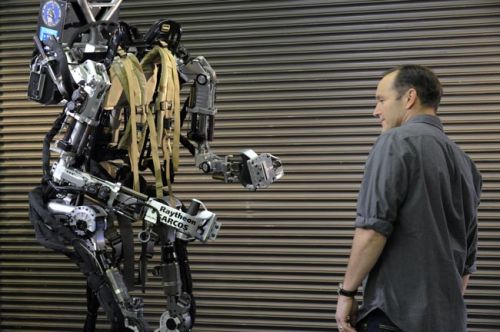
Obviously, the benefits of such a "gadget" is very great. Compared to the previous model, the ekoskeleton has become much better.
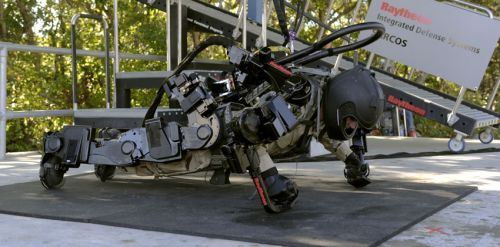
For 2011, the company planned to transfer the model to an autonomous source of energy, and the XOS team successfully coped with the task. Engineers have improved high-pressure hydraulic actuators so that they need pressure only at the moment of the start of the action — for example, to raise a limb after the operator. This made it possible to use for powering a light internal combustion engine, which has enough fuel for eight hours of operation.

The performance of the XOS team for 2 years is impressive. Engineers were able to come close to embody the fantasy of creating an individual war machine for the military and a revolutionary prosthesis for the infirm people. Of course, this is not a costume from Krayzis, but we will wait another ten years and we will see something like that!
The third version is already in development and if we take into account progress in this area for 2 years, then what will happen in 15-20 years. I believe that in the near future, such exoskeletons can be used in construction or in rescue operations. According to the developers, now an employee using an exoskeleton works four times more efficiently than without him. The main disadvantage is the inability to work from portable energy sources, as they heavily weight the structure. Perhaps this problem will be solved by introducing into the use of "energy by air".
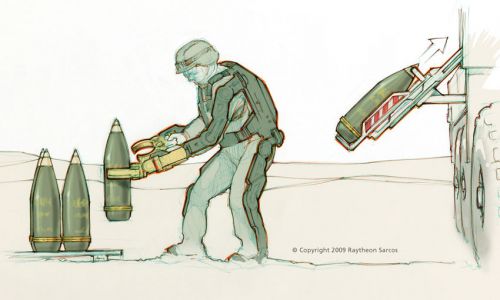
According to the creators of XOS 2, weapons, rockets, boxes of grenades and bazookas are heavy things, and injuries among personnel in warehouses happen very often. The fighter did not correctly assess the weight, took on too much - and consider the finished disabled person with a diagnosis of "protrusion of the intervertebral disk." And then pay him a lifetime military pension - burdensome for the budget.
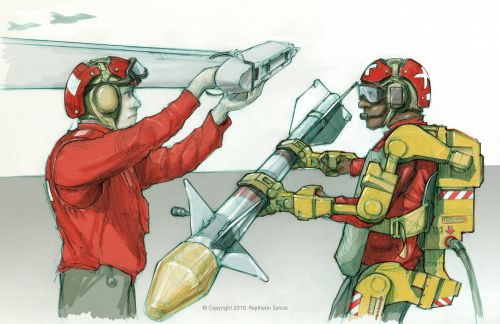
A soldier “dressed” in XOS 2 will be able to do work for two to three people.
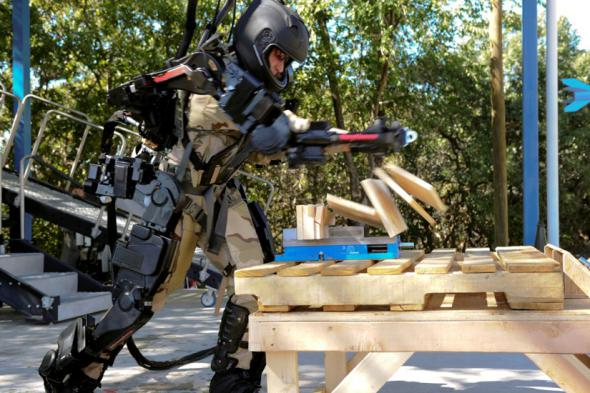
See a demonstration of their capabilities:
HAL 9000
The author of this exoskeleton is the Japanese company Cyberdyne Systems (yes, you heard right, this is the company that created SkyNet in the movie “Terminator”). The developers themselves call the high-tech suit a “robot assistant” who will help older people and people with disorders of the musculoskeletal system. Already today it can be rented. The main feature of the exoskeleton is autonomy, it can work without recharging for about 5 hours. Unlike XOS 2, the development is "home".

HULC (Human Universal Load Carrier)

The exoskeleton from Berkeley Bionics turns a person who dressed him into a real HALKA. In fact, everything is much more modest. The main function of the development is to assist in carrying large loads over long distances, an indispensable thing for the army. It allows you to carry about 90 kilograms, while feeling as if you are carrying a 20 kilogram backpack. The exoskeleton has a flexible design that allows you to run and crouch. Again, the main disadvantage of development is the low capacity of portable batteries.
Exoskeleton of the future
Well, let's fantasize a little. An exoskeleton can do more than just increase strength. Being a concentration of emerging technologies, it will allow to turn any soldier into a real superfighter, with armor-skinned, extra-sensory and six-meter vertical jump.

Instant change of functionality
Date: 2009
Developer: Raytheon Sarcos
A number of easily accessible controls on the forearm will allow the operator to quickly perform certain actions. The reset button will allow the soldier to quickly throw off the exoskeleton, while another button could provide an automated adrenaline equivalent: a surge of energy through the costume will be able to prepare for a short, intense action, such as a sprint from a danger zone.
Evacuation
Date: 2010
Developer: Raytheon Sarcos
Raytheon Sarcos tested a prototype of a kind of descending platform on which wounded soldiers could be located so that emergency response teams and military physicians could provide first aid and evacuate. Even current exoskeletons can easily carry a 90 kilogram person on their back.
Recharge
Date: this year
Developer: Berkeley Bionics
Berkeley Bionics creates a power system that uses the power of each step to recharge itself, just like hybrid cars get their braking power. Meanwhile, Raytheon Sarcos is working on an engine that will power the exoskeleton and serve as a recharging station for electronic and communications equipment for the soldiers.
Communications
Date: 2013
Developer: US Army
The display built into the helmet will display information about the health, charge level of the suit, chemical and exogenous sensors, as well as the position on the battlefield of the fighter and his allies, display a picture of unmanned and remotely operated vehicles.
Run like an Olympian
Date: 2013
Developer: Mil and Raytheon Sarcos
At MIT, Hugh Herr, an expert in orthopedics, creates ankles, knees, and hips that save energy by allowing your legs to move freely, as we do when we walk, instead of spending considerable effort on every movement. Raytheon Sarcos redesigned the ankles so that the operator can move his toes at the end of each step, which in turn will increase the walking speed over today's 9.5 km / h.
Use of any weapon
Date: 2015
Costumes can have various manipulators that will allow the use of complex sets of weapons and / or repair equipment, which now requires specialized repair equipment.
Lift 5 tons
Date: 2018
Developer: Institute for Soldier Nanotechnologies (ISN), Masachusets institute of technology (MIT)
Chemist Timothy Swager and engineer Ian Hunter have developed a new polymer that shrinks like an accordion when it receives an electric charge. In laboratory tests, the samples created showed a strength almost 100 times greater than natural muscle.
Automated wound healing
Date: 2018
Developer: ISN and the US Army Natick Soldier Research, Development and Enginering Center
If the soldier was injured, the sensors in his suit will record the bleeding and, through a network of artificial "veins", deliver a blood-thickening agent and drugs. In addition, the suit can monitor blood pressure and heart rate so that the medical team can monitor its health.
Pass through bullets
Developer: ISN
Date: 2018
Although the exoskeleton may have heavy armor, a lower weight solution is in operation. MIT engineer Ned Thomas redesigned the bullet-proof material so that its molecules have a viscous structure.
In my opinion, the exoskeleton is the safest and most effective model of strengthening and improving human capabilities in the future. After all, to use it, it is not necessary to drastically change the organic part of the symbiosis, that is, the person himself (as opposed to other cyber-organic experiments). As a result of evolution, any living creatures will adapt to the environment and it is possible that with time a person will have to become stronger and more protected. An exoskeleton for this is almost an ideal tool.
PS Here is a small selection of posts about exoskeletons.
US Army Tests HULC Robotic Exoskeleton
Armed exoskeleton from sarcos'a
Exoskeleton - wheelchair replacement
Exoskeletons in Avatar
Honda exoskeleton

This time we want to tell you about exoskeletons. If anyone does not know, this is such a costume, similar to the one that Tony Stark put on himself in “Iron Man”. What, did not watch this movie? And the comics are not read? Then go under the cut, tell you everything, and most importantly - show.
Exoskeleton (from the Greek. Έξω - external and σκελετος - skeleton) - a device designed to increase the muscular strength of a person due to the external frame.
')
The exoskeleton repeats human biomechanics for a proportional increase in effort during movements. According to reports of open press, real-life samples are currently created in Japan and the USA. The exoskeleton can be integrated into the spacesuit.
Iron Man is a character in the Marvel universe, an amazing symbiosis of man and machine, which gives him superpowers. The very idea of a costume that has almost unlimited possibilities is far from reality, but the first steps in this direction already exist. In this article I want to talk about several developments that are referred to as "Real Life Iron-Man." Perhaps in the future, these prototypes will become our daily routine.
XOS 2
In 2000, DARPA launched a $ 75 million program to develop an exoskeleton suitable for practical use. Part of the money was received by the American company Sarcos, in 2007 purchased by Raytheon. And in 2008, the first model of the XOS 1 exoskeleton was presented. It had compact motion drives, improved sensors for muscular activity and more efficient hydraulic valves. Sensors located on different parts of the body transmit information to the onboard computer located on the back of the exoskeleton, which coordinates its movements in such a way that the owner does not experience any fatigue during heavy physical exertion. The operator of the exoskeleton could carry a weight of up to 100 kg behind his back. However, the model had a significant drawback - the power cable limiting movement.
In the autumn of 2010, an updated version of XOS 2 was presented. The weight of the model was reduced by 10 kg, and the power consumption was reduced by 50%, but the developers failed to disconnect the power cable.

Obviously, the benefits of such a "gadget" is very great. Compared to the previous model, the ekoskeleton has become much better.

For 2011, the company planned to transfer the model to an autonomous source of energy, and the XOS team successfully coped with the task. Engineers have improved high-pressure hydraulic actuators so that they need pressure only at the moment of the start of the action — for example, to raise a limb after the operator. This made it possible to use for powering a light internal combustion engine, which has enough fuel for eight hours of operation.

The performance of the XOS team for 2 years is impressive. Engineers were able to come close to embody the fantasy of creating an individual war machine for the military and a revolutionary prosthesis for the infirm people. Of course, this is not a costume from Krayzis, but we will wait another ten years and we will see something like that!
The third version is already in development and if we take into account progress in this area for 2 years, then what will happen in 15-20 years. I believe that in the near future, such exoskeletons can be used in construction or in rescue operations. According to the developers, now an employee using an exoskeleton works four times more efficiently than without him. The main disadvantage is the inability to work from portable energy sources, as they heavily weight the structure. Perhaps this problem will be solved by introducing into the use of "energy by air".

According to the creators of XOS 2, weapons, rockets, boxes of grenades and bazookas are heavy things, and injuries among personnel in warehouses happen very often. The fighter did not correctly assess the weight, took on too much - and consider the finished disabled person with a diagnosis of "protrusion of the intervertebral disk." And then pay him a lifetime military pension - burdensome for the budget.

A soldier “dressed” in XOS 2 will be able to do work for two to three people.

See a demonstration of their capabilities:
HAL 9000
The author of this exoskeleton is the Japanese company Cyberdyne Systems (yes, you heard right, this is the company that created SkyNet in the movie “Terminator”). The developers themselves call the high-tech suit a “robot assistant” who will help older people and people with disorders of the musculoskeletal system. Already today it can be rented. The main feature of the exoskeleton is autonomy, it can work without recharging for about 5 hours. Unlike XOS 2, the development is "home".

HULC (Human Universal Load Carrier)

The exoskeleton from Berkeley Bionics turns a person who dressed him into a real HALKA. In fact, everything is much more modest. The main function of the development is to assist in carrying large loads over long distances, an indispensable thing for the army. It allows you to carry about 90 kilograms, while feeling as if you are carrying a 20 kilogram backpack. The exoskeleton has a flexible design that allows you to run and crouch. Again, the main disadvantage of development is the low capacity of portable batteries.
Exoskeleton of the future
Well, let's fantasize a little. An exoskeleton can do more than just increase strength. Being a concentration of emerging technologies, it will allow to turn any soldier into a real superfighter, with armor-skinned, extra-sensory and six-meter vertical jump.

Instant change of functionality
Date: 2009
Developer: Raytheon Sarcos
A number of easily accessible controls on the forearm will allow the operator to quickly perform certain actions. The reset button will allow the soldier to quickly throw off the exoskeleton, while another button could provide an automated adrenaline equivalent: a surge of energy through the costume will be able to prepare for a short, intense action, such as a sprint from a danger zone.
Evacuation
Date: 2010
Developer: Raytheon Sarcos
Raytheon Sarcos tested a prototype of a kind of descending platform on which wounded soldiers could be located so that emergency response teams and military physicians could provide first aid and evacuate. Even current exoskeletons can easily carry a 90 kilogram person on their back.
Recharge
Date: this year
Developer: Berkeley Bionics
Berkeley Bionics creates a power system that uses the power of each step to recharge itself, just like hybrid cars get their braking power. Meanwhile, Raytheon Sarcos is working on an engine that will power the exoskeleton and serve as a recharging station for electronic and communications equipment for the soldiers.
Communications
Date: 2013
Developer: US Army
The display built into the helmet will display information about the health, charge level of the suit, chemical and exogenous sensors, as well as the position on the battlefield of the fighter and his allies, display a picture of unmanned and remotely operated vehicles.
Run like an Olympian
Date: 2013
Developer: Mil and Raytheon Sarcos
At MIT, Hugh Herr, an expert in orthopedics, creates ankles, knees, and hips that save energy by allowing your legs to move freely, as we do when we walk, instead of spending considerable effort on every movement. Raytheon Sarcos redesigned the ankles so that the operator can move his toes at the end of each step, which in turn will increase the walking speed over today's 9.5 km / h.
Use of any weapon
Date: 2015
Costumes can have various manipulators that will allow the use of complex sets of weapons and / or repair equipment, which now requires specialized repair equipment.
Lift 5 tons
Date: 2018
Developer: Institute for Soldier Nanotechnologies (ISN), Masachusets institute of technology (MIT)
Chemist Timothy Swager and engineer Ian Hunter have developed a new polymer that shrinks like an accordion when it receives an electric charge. In laboratory tests, the samples created showed a strength almost 100 times greater than natural muscle.
Automated wound healing
Date: 2018
Developer: ISN and the US Army Natick Soldier Research, Development and Enginering Center
If the soldier was injured, the sensors in his suit will record the bleeding and, through a network of artificial "veins", deliver a blood-thickening agent and drugs. In addition, the suit can monitor blood pressure and heart rate so that the medical team can monitor its health.
Pass through bullets
Developer: ISN
Date: 2018
Although the exoskeleton may have heavy armor, a lower weight solution is in operation. MIT engineer Ned Thomas redesigned the bullet-proof material so that its molecules have a viscous structure.
In my opinion, the exoskeleton is the safest and most effective model of strengthening and improving human capabilities in the future. After all, to use it, it is not necessary to drastically change the organic part of the symbiosis, that is, the person himself (as opposed to other cyber-organic experiments). As a result of evolution, any living creatures will adapt to the environment and it is possible that with time a person will have to become stronger and more protected. An exoskeleton for this is almost an ideal tool.
PS Here is a small selection of posts about exoskeletons.
US Army Tests HULC Robotic Exoskeleton
Armed exoskeleton from sarcos'a
Exoskeleton - wheelchair replacement
Exoskeletons in Avatar
Honda exoskeleton
Source: https://habr.com/ru/post/126752/
All Articles